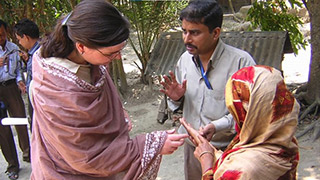
Molly Kile, Sc.D., resolutely uncovers threats to populations most vulnerable from environmental exposures, including children and families living in areas with limited resources.
An environmental epidemiologist at Oregon State University (OSU), Kile works with communities in rural, low-resource, and primarily minority regions in the U.S. and abroad to understand and address their needs.
Kile’s passion for protecting children’s environmental health grew out of her doctoral training at the Harvard University NIEHS-funded Superfund Research Program (SRP) Center. She was mentored by David Christiani, M.D., who was studying arsenic exposure in Bangladesh.
“My work with Dr. Christiani allowed me to travel to Bangladesh and live with a community for a month. Through conversations with families, I learned that their primary concern was understanding how contaminants affect the health of their children and how to protect them,” Kile reflected. “That trip was an epiphany that helped shape the research I am conducting today.”
Arsenic Research in Bangladesh
Early in her career, Kile received a Mentored Research Scientist Development Award grant from NIEHS. The award allowed her to combine formal education with mentorship and training to start addressing the health concerns she heard about in Bangladesh, such as how arsenic exposure during pregnancy affects the health of a mother and her baby.

Kile’s work in Bangladesh provided insight that linked arsenic exposure during pregnancy to low birth weight and disruptions to the developing immune system.
Building on those research findings, Kile, colleagues at Harvard, and community partners in Bangladesh developed prenatal health care and well-baby care at Dhaka Community Hospital Trust and their rural health clinics. Their work also informed new Bangladeshi policies for safe drinking water options in communities impacted by arsenic contamination.
“One of the key lessons I learned is that partnering with a local organization that residents trust and that can explain the value of research is critical,” Kile reflected. “Those partnerships help us build trust within the community and hold us accountable to make sure our work benefits residents.”
Serving Native American Communities
Kile applies the lessons she learned working with communities in Bangladesh to her role leading the Community Engagement Core at the OSU SRP Center. Her team partners with Native American tribes in the Pacific Northwest to address their concerns about environmental pollutants, such as polycyclic aromatic hydrocarbons (PAHs).
For example, Kile and team have partnered with trusted leaders within tribal communities to facilitate bidirectional research. The collaborators help tribal members understand the health threats from PAH exposure and develop culturally appropriate strategies to protect their health.
“When working with Native American communities, you have to be respectful of their sovereignty and their right to decide how environmental samples and information will be collected, analyzed, used, and shared with outsiders,” Kile said. “A big component of our work is teaching university-based researchers how to conduct and communicate research in a way that respects Tribal Nations and nurtures current and future relationships.”
Translating Research into Action
Kile also co-leads OSU’s NIEHS-funded Advancing Science, Practice, Programming and Policy in Research Translation for Children's Environment Health (ASP3IRE) Center. The center aims to translate findings from children’s environmental research into interventions that can reduce children’s exposure to pollutants and improve their health and well-being.
“We’re trying to accelerate the uptake of policies, programs, and practices that will mitigate environmental exposures before they can harm children’s health,” said Kile. “The ASP3IRE Center is a wonderful collaboration between researchers from different disciplines who all share a common goal of improving children’s health and well-being.”
The team is committed to working with local organizations that support children and families. For example, they launched a pilot project program for community-based organizations, healthcare providers, and learning centers, among others to propose and test interventions that can improve children’s environmental health.
“A lot of environmental exposures, especially in a person’s home, are controllable,” Kile reflected. “I hope that by providing communities with the right support, education, and resources, we can empower them to make and inform changes to protect their health and well-being.”
Molly Kile

